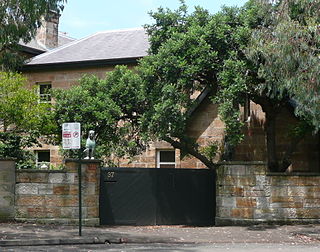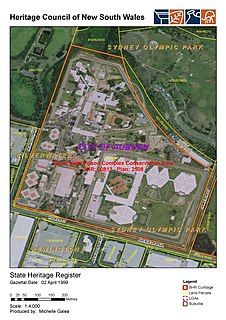
Admiralty House is the Sydney official residence of the Governor-General of Australia. It is located in the suburb of Kirribilli, on the northern foreshore of Sydney Harbour. This large Victorian Regency and Italianate sandstone manor, completed in stages based on designs by James Barnet and Walter Liberty Vernon, occupies the tip of Kirribilli Point. Once known as "Wotonga", it has commanding views across Sydney Harbour to the Sydney Harbour Bridge and the Sydney Opera House.

Marrickville is a suburb in the Inner West of Sydney, in the state of New South Wales, Australia. Marrickville is located 7 kilometres south-west of the Sydney central business district and is the largest suburb in the Inner West Council local government area.

Dulwich Hill is a suburb in the Inner West of Sydney, in the state of New South Wales, Australia. It is 7.5 kilometres south-west of the Sydney central business district, in the local government area of Inner West Council. Dulwich Hill stretches south to the shore of the Cooks River.

Tempe is a suburb in the Inner West of Sydney, in the state of New South Wales, Australia. Tempe is located 9 kilometres south of the Sydney central business district in the local government area of Inner West Council.

Australian residential architectural styles have evolved significantly over time, from the early days of structures made from relatively cheap and imported corrugated iron to more sophisticated styles borrowed from other countries, such as the Victorian style from the United Kingdom, the Georgian style from North America and Europe and the Californian bungalow from the United States. A common feature of the Australian home is the use of fencing in front gardens, also common in both the UK and the US.

Tresco is a heritage-listed residence located at 97 Elizabeth Bay Road, Elizabeth Bay, City of Sydney, New South Wales, Australia. It was designed by Thomas Rowe and built by Rowe from 1867 to 1883. The property is privately owned. It was added to the New South Wales State Heritage Register on 2 April 1999. The property has previously functioned as a private residence, navy housing and homestead and was originally indigenous lands. Prior to 2004 it was owned by the Royal Australian Navy and served as an official residence for the senior naval officers in New South Wales.

Rhyndarra is a heritage-listed residence located at 23 Riverview Place, Yeronga, City of Brisbane, Queensland, Australia. The architect was Andrea Stombuco. It was built from 1888 to 1938. It is also known as No. 2 Women's Hospital, Australian Military Forces 1st Military Hospital, National Service Training Hospital, No. 1 Camp Hospital, and Yeronga Girls' Industrial School. It was added to the Queensland Heritage Register on 7 February 2005.

Boothville is a heritage-listed villa and former maternity hospital at 43 Seventh Avenue, Windsor, City of Brisbane, Queensland, Australia. It was built from 1887 to c. 1900. It is also known as Monte Video. It was added to the Queensland Heritage Register on 21 October 1992.

Silverwater Prison Complex Conservation Area is a heritage-listed complex consisting of a historic house and various prison structures associated with what is now known as the Silverwater Correctional Complex, located at Holker Street, Silverwater, Cumberland Council, New South Wales, Australia. It was designed by John Verge and Walter Liberty Vernon and built from 1829 to 1850. It is also known as Silverwater Correctional Centre, Mulawa Correctional Centre, Silverwater Gaol, Newington Estate, Silverwater State Hospital and State Hospital & Asylum for Women. The property is owned by Corrective Services NSW. It was added to the New South Wales State Heritage Register on 2 April 1999.

Camden is a heritage-listed residence at 60 Prospect Street, Rosehill, City of Parramatta, New South Wales, Australia. It was built in 1883. It was added to the New South Wales State Heritage Register on 2 April 1999.

Cranbrook is a heritage-listed residence at 14 Australia Street, Camperdown, Inner West Council, New South Wales, Australia. It was built from 1879 to 1881. It is also known as Fowlers House. It was added to the New South Wales State Heritage Register on 2 April 1999.

Premier Street Sewer Vent and Cottages is a heritage-listed sewer vent and cottages at 24 and 26 Premier Street, Marrickville, Inner West Council, New South Wales, Australia. It was designed by the New South Wales Public Works Department, which built it from 1898 to 1900. It was added to the New South Wales State Heritage Register on 15 November 2002.

Nelson Lodge is a heritage-listed residence at 125 Unwins Bridge Road, Tempe, Inner West Council, New South Wales, Australia. It was built in 1858. It is also known as Milford Haven and Leinster Hall. It was added to the New South Wales State Heritage Register on 2 April 1999.

The Campbelltown Post Office is a heritage-listed former post office and now shops and office space at 261 Queen Street, Campbelltown, City of Campbelltown, New South Wales, Australia. It was designed by James Barnet and built in 1881. It is also known as Campbelltown Post Office (former). The property is privately owned. It was added to the New South Wales State Heritage Register on 2 April 1999.

Bomera and Tarana are two jointly heritage-listed residences at 1 Wylde Street in the inner city Sydney suburb of Potts Point in the City of Sydney local government area of New South Wales, Australia. Bomera was designed by John F. Hilly and built in 1856 with alterations by Sheerin & Hennessy and built by Wheelwright & Alderson c. 1902. Tarana was designed by Edward H. Buchanan and built by John Alexander Oag in 1889, with additions including a third storey designed by Sheerin & Hennessy in 1907. The houses are also known as Boomera and Taranah. The property was added to the New South Wales State Heritage Register on 23 June 2000.

Rockwall is a heritage-listed house and former school at 7 Rockwall Crescent in the inner city Sydney suburb of Potts Point in the City of Sydney local government area of New South Wales, Australia. It was designed by John Verge and built from 1831 to 1837. It was added to the New South Wales State Heritage Register on 2 April 1999.

Clydebank is a heritage-listed residence at 43 Lower Fort Street, in the inner city Sydney suburb of Millers Point in the City of Sydney local government area of New South Wales, Australia. It was built from 1824 to 1825 by Robert Crawford. It is also known as Bligh House, Holbeck and St Elmo. It has also served as an art gallery and as offices in the past. It was added to the New South Wales State Heritage Register on 2 April 1999.

79 Lower Fort Street is a heritage-listed former hotel and now shop and residence at 79 Lower Fort Street, Millers Point, City of Sydney, New South Wales, Australia. It was built in 1842 as a hotel, and variously traded as a hotel or shop until 1870, after which time it operated solely as a shop. It was variously known as the Young Princess Hotel, Whalers Arms Hotel and Brown's Family Hotel in its licensed years. It was added to the New South Wales State Heritage Register on 2 April 1999.

115-121 Kent Street, Millers Point are heritage-listed terrace houses located at 115-121 Kent Street, in the inner city Sydney suburb of Millers Point in the City of Sydney local government area of New South Wales, Australia. The property was added to the New South Wales State Heritage Register on 2 April 1999.

Maryborough Post Office is a heritage-listed post office at 69 Clarendon Street, Maryborough, Victoria, Australia. It was designed by John Hudson Marsden and built in 1876-77, with the clock tower added in 1879. It was originally built as a combined court house, post and telegraph office and Colonial office, though the post office alone has occupied the building since 1892. It was added to the Australian Commonwealth Heritage List on 8 November 2011.





























